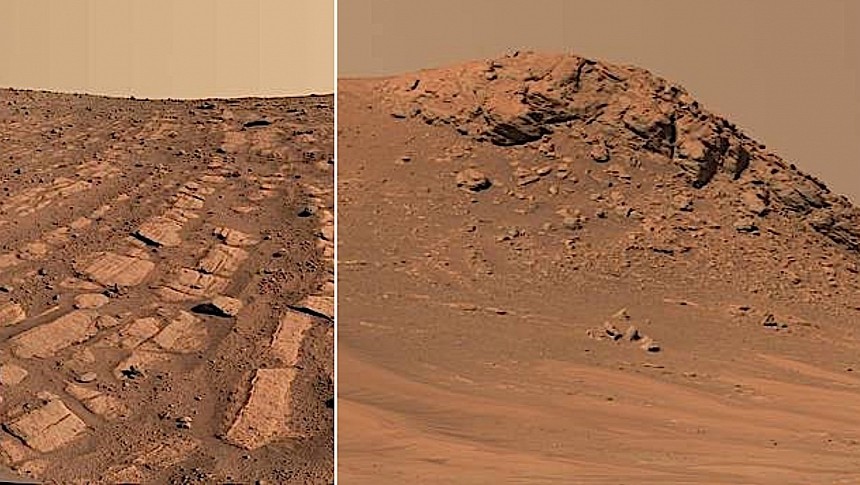It wasn't all that long ago that we humans were still wondering if neighboring Mars ever had liquid water. Somehow, that knowledge became a fact these past few years, and now we know for certain that rivers and lakes were a given up there a long, long time ago.
It was back in 2015 when we even learned that "liquid water flows intermittently on present-day Mars." That's right, signs of water in its liquid, life-giving form has been detected by the Mars Reconnaissance Orbiter (MRO).
Sure, there's no Amazon or Mississippi to talk about right now, but as new evidence uncovered by the Perseverance rover and made public this week shows, the rivers of Mars in some cases were deeper and faster moving than previously believed.
Perseverance landed on Mars in 2021, in a region of the planet called the Jezero Crater. Its mission profile is very rich, including even the generation of oxygen and sampling of the soil. Over the past year or so however, it looked like the machine was relegated to Ingenuity-helicopter-companion status, and made to pick and store Martian soil for the upcoming Sample Return Mission.
This week's announcement is the first in a long time that's the result of the rover actually performing a science mission there. And by science mission I mean the thing looking down range and taking pictures.
At the time of writing the rover is still located in the Jezero Crater. It recently moved to the top of a "fan-shaped pile of sedimentary rock." It's a feature 820 feet (250 meters) tall and filled with curving layers that could point to the flow of water. It's a place people here on Earth have long snapped on camera from space, but are only now able to experience a bit more directly.
We've known ever since the discoveries made by the Curiosity rover in the Gale Crater that water flowed on Mars in shallow streams. What the Perseverance found, however, is evidence of "a rollicking river on Mars."
Many of the photos of the region snapped by the rover's Mastcam-Z instrument were stitched together to form the image of a river that was once "truckin’ and carrying a lot of debris." More to the point, a lot of coarse sediment grains and cobbles were found.
And since we know for a fact that the deeper and faster a river, the more and larger the pieces of material it can move, the conclusion was obvious: Mars once had what may be perceived as raging rivers. Who knows, maybe just raging enough to allow for some local lifeform to engage in the Martian version of rafting.
Joking aside, the discovery is an important one, and will probably have the science community "rethink what watery environments looked like on ancient Mars." Until then, it can serve as a tool to better determine where to look for signs of ancient microbial life.
Sure, there's no Amazon or Mississippi to talk about right now, but as new evidence uncovered by the Perseverance rover and made public this week shows, the rivers of Mars in some cases were deeper and faster moving than previously believed.
Perseverance landed on Mars in 2021, in a region of the planet called the Jezero Crater. Its mission profile is very rich, including even the generation of oxygen and sampling of the soil. Over the past year or so however, it looked like the machine was relegated to Ingenuity-helicopter-companion status, and made to pick and store Martian soil for the upcoming Sample Return Mission.
This week's announcement is the first in a long time that's the result of the rover actually performing a science mission there. And by science mission I mean the thing looking down range and taking pictures.
At the time of writing the rover is still located in the Jezero Crater. It recently moved to the top of a "fan-shaped pile of sedimentary rock." It's a feature 820 feet (250 meters) tall and filled with curving layers that could point to the flow of water. It's a place people here on Earth have long snapped on camera from space, but are only now able to experience a bit more directly.
We've known ever since the discoveries made by the Curiosity rover in the Gale Crater that water flowed on Mars in shallow streams. What the Perseverance found, however, is evidence of "a rollicking river on Mars."
Many of the photos of the region snapped by the rover's Mastcam-Z instrument were stitched together to form the image of a river that was once "truckin’ and carrying a lot of debris." More to the point, a lot of coarse sediment grains and cobbles were found.
And since we know for a fact that the deeper and faster a river, the more and larger the pieces of material it can move, the conclusion was obvious: Mars once had what may be perceived as raging rivers. Who knows, maybe just raging enough to allow for some local lifeform to engage in the Martian version of rafting.
Joking aside, the discovery is an important one, and will probably have the science community "rethink what watery environments looked like on ancient Mars." Until then, it can serve as a tool to better determine where to look for signs of ancient microbial life.

















